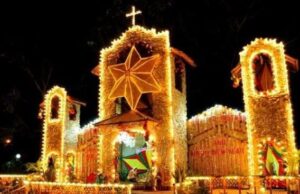Christmas carols are already being played in stores and on radio stations while the rest of the world prepares for other holidays like Thanksgiving and Halloween. Restaurants and hotel lobbies are decorated for Christmas with glittering ornaments.
Then there are the various pre-Christmas sales and events. Welcome to the Philippines! All of these festivities begin on September 1 and last until January 6 during the Feast of the Three Kings, making this the world’s longest Christmas.
Filipinos were raised in this culture; but, when did it start? The reason why the Philippines celebrates it for the longest of any other nation is determined by experts. Perhaps you believe that Catholicism is all that Filipinos are.
This could be one explanation, but sociologists assert that the Advent season, or the preparation for the Nativity of Jesus Christ, begins four Sundays before Christmas Day, or somewhere in the latter part of the previous week or the first few days of the following month.
Who then declared that Christmas was to start in September? Jose Mari Chan, perhaps? Mariah Carey, maybe?
Here are some of the explanations for why the Philippines celebrates Christmas for the longest period in the entire world.
Filipinos feel like they own Christmas
The Philippines also feel a sense of Christmas ownership thanks to the customs and religious beliefs of the holiday. Even before the contemporary era, there were a lot of festivities centered around Christmas, including traditional reenactments like Simbang Gabi.
Simbang Gabi first appeared in 1669 as a workable remedy in the Philippines during the early years of Spanish rule for farmers who began working before sunrise to avoid the morning on the fields. Instead of the nightly novenas that were more typical in the rest of the Hispanic world, priests started saying Mass in the early morning hours.
This well-known Christmas custom quickly established itself as a distinctive aspect of Philippine culture and one of the holiday’s primary symbols.
Christmas is more than just a religious holiday. It is very culturally appropriate that families be reunited and that OFWs return home. Christmas is about the family unit as well as the birth of a child. Overseas Filipino Workers (OFWs), who reside and work abroad, frequently visit their family during the holidays.
To Celebrate and Enjoy Festivals
Christmas is highly regarded in the Philippines since it is primarily seen as a festivity. This meant that Christmas celebrations already adhere to cultural norms, setting them apart from others throughout the year.
The way the Church celebrates Christmas—during the Advent season—has an impact on the upbeat attitude about the holiday. It is a favorable preparation for the return of Christ. In this way, the Philippines’ upbeat mentality is spiritual: consider Misa de Gallo, Christmas carol singing, outreach initiatives, and more.
With more than 80% of the population identifying as Catholic as of 2010, the Filipinos likewise celebrate Christmas as a primarily religious holiday.
Similar to how Filipinos celebrate Christmas, festivals in the Philippines are acts of thanksgiving. The main distinction between festivals in the Philippines is the link between a healthy harvest and the town’s patron saint. Fiestas hold a special significance for many Filipinos because of the saints’ enduring power of miracles. All of one’s luck and favors are attributed to the saints, according to popular belief.
Pre-Christmas Airline Promotions And Mall Sales
Mall lobby doors and entrances are adorned with shiny Christmas decorations. Then there are the sporadic deals and activities leading up to Christmas. Ads for airline holidays start to appear. Invitations to get together and go out to eat start to come in from friends and family.
Many claims that restaurant proprietors and mall owners influence customers into making purchases. Some could even believe that these companies “hypnotize” customers into spending money on Christmas as early as September. In the Philippines, this is not the situation. For Filipinos, festivals are meant to be joyful occasions, but they also have a financial component that must be considered:
Filipinos are willing to invest. Well, despite what some Filipinos might believe, they still have a lot of purchasing power because the holiday season encourages gift-giving, dining out with friends and family, and overindulging in food. Malls did not invent this custom. Malls and businesses only react to consumer behavior, and they have a fantastic opportunity to meet demand.
People today opt to skip a trip to the mall to escape the so-called “Christmas rush,” which results in high traffic and long lineups at the checkout. Additionally, factors #5 and #6 opened the door for earlier mall promotions and sales.
Please Read: Online shopping fraud this holiday season
The Lack of Festive Celebrations During the “Ber” Months
Although the Philippines has one of the highest numbers of holidays in the world, there are only two non-working holidays during the “Ber” months: All Saints Day (November 1) and All Saints Day (November 2). (November 2). When President Rodrigo Duterte signed Republic Act 10966 into law in the Philippines in 2018, the Feast of Mary’s Immaculate Conception on December 8 became a recognized holiday.
The yearly Oktoberfest, which takes place in Munich, Germany, and dates back to 1810, can only be discussed one particular beverage brand in the Philippines. Beer consumption and alcohol-related events are even prohibited in the country.
Aguinaldo or Giving Presents
With its extensive commercialization and the custom of giving gifts, Christmas is regarded as a joyful time of the year. As the Filipino culture celebrates unity and joy, Christmas is in and of itself a fanfare of blessings.
The family is connected to the pleasures of journeys, pricey gifts, abundant festivals, sales, and everything else. Filipinos have a strong sense of nostalgia for things that have transpired over the last year, and they often feel compelled to give someone a present, no matter how modest, to show that they are grateful and remembered.
They can reaffirm their sense of commitment to one another through gift-giving. Filipinos often affirm this over the Christmas season.
Children receive gifts from their numerous titos, titas, ninongs, and ninangs on Christmas Eve and Christmas Day since Filipino families, both immediate and extended, meet together for these occasions. The customary “mano,” a Filipino gesture used to show respect for elders, opens the gathering. Aside from youngsters, some adults may urge their children to sing, dance, play an instrument, or read poetry in exchange for their Aguinaldo of gifts, which could be money or toys.
The Noche Buena And Family Reunions
In most nations, Christmas morning is spent with family and friends. After the Christmas Midnight Mass, people in the Philippines gather with their families and extended families to celebrate.
The traditional Noche Buena is a celebratory event that frequently serves as a get-together for individuals who attend dressed to the nines and cooking traditional dishes like Lechon, queso de bola, ham, and family recipes. After all, food binds all of humanity together. But in the Philippines, there is some major feasting.
Without the whole roasted pig, or lechon, which can weigh between 10 and 20 kilos, no Filipino Christmas dinner is complete. Rows of roasted pigs are lined up along the streets in La Loma, Quezon City, which is known as the lechon capital of the Philippines. Nearly 200 pieces of lechon are sold at one stall each day for between 5,000 and 8,000 pesos.
Conclusion
It turns out that Filipinos are extremely into anything that will allow them to enjoy Christmas and spend more time with loved ones, which is the main driver behind this long-standing custom.
They have a psychological framework that causes them to count down the days until major events. On September 16, the countdown to Christmas begins, but Filipinos like to start their celebrations earlier. They will be able to better manage their time if they know how much time they have to finish a task and don’t worry about it.
Additionally encouraging them to finish their Christmas chores before the big day is a countdown to 100 days. In other words, the way of thinking of Filipinos is hardwired to view the months leading up to Christmas as an opportunity to purchase gifts, decorate the Christmas tree and other holiday decorations, organize the Noche Buena, and book Christmas parties.
Most importantly, Filipinos use this occasion to gather with loved ones, friends, and coworkers they haven’t seen in a while over the delectable fare, much as their predecessors did. This has most likely contributed to the tradition’s effective transmission from one generation to the next.





